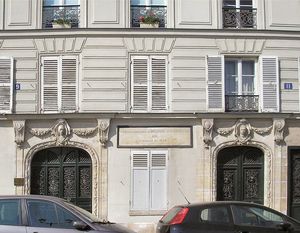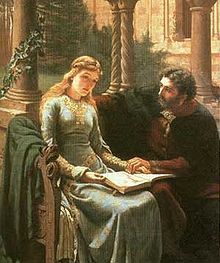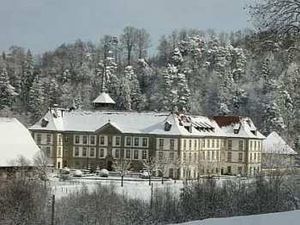Abelard and Heloise: Eternal sunshine of the spotless mind
 Today, I wandered off in the direction of the IVè, metro Hôtel de Ville. My mission: the house of Abelard and Héloïse. The story of their tragic, thwarted love has always touched me, and I realised I had never visited their residence on Quai aux Fleurs (belonging to Heloise's uncle, I believe). Time to rectify that. Abelard and Heloise are the never-forgotten Romeo and Juliette of Paris, indeed...
Today, I wandered off in the direction of the IVè, metro Hôtel de Ville. My mission: the house of Abelard and Héloïse. The story of their tragic, thwarted love has always touched me, and I realised I had never visited their residence on Quai aux Fleurs (belonging to Heloise's uncle, I believe). Time to rectify that. Abelard and Heloise are the never-forgotten Romeo and Juliette of Paris, indeed...
Here is their tale as simply told on a site dedicated to them - there's a new musical based on their story (listen HERE):
In twelfth century Paris, the intellectually gifted young Heloise, the niece of Notre Dame’s Canon Fulbert, strives for knowledge, truth and the answer to the question of human existence. It soon becomes apparent that only one teacher in Paris can provide the education that she seeks. Though twenty years her senior, Abelard quickly becomes intrigued by Heloise’s uncommon wit and intelligence, for Heloise is on par intellectually with Abelard.
 They soon find themselves so entwined that neither can resist the spiritual and physical desires of their bodies, yet they both know that the laws of the time forbid such a relationship. But their physical love and the strength of their passion proved to be a power impossible to resist.
They soon find themselves so entwined that neither can resist the spiritual and physical desires of their bodies, yet they both know that the laws of the time forbid such a relationship. But their physical love and the strength of their passion proved to be a power impossible to resist.
When Heloise becomes pregnant, they realize it is not safe for her to remain in Paris. They flee for Brittany, Abelard’s place of birth. In a scheme to protect the dignity of his fallen niece, and return Heloise to his home, Canon Fulbert arranges a secret marriage between Heloise and Abelard. But shortly after the two lovers are wed, they discover Fulbert’s true plot is to ruin Abelard and keep Heloise for himself. For her safety, Heloise escapes to the convent at Argenteuil, but it is too late for Abelard and he is brutally attacked in Paris. (my note: Fulbert's revenge was not only to catch and give Abelard a good basting - his hired mob also castrated him)
As a result of his humiliating punishment, Abelard no longer considers himself capable of continuing as a teacher at Notre Dame, and he and Heloise understand what they must do. Canon Bedell pleads with Abelard not to force such a fate upon 
Heloise, but both Heloise and Abelard agree that they must take Holy Orders as Monk and Nun. Heloise must give up her child, knowing that she will never see him again.
Through their famous correspondence of twenty years, their love continues to flourish, in spite of their separation. After many years pass, in a chance meeting, Heloise and Abelard are briefly reunited at a ceremony in Paris. Though they have been physically apart all these years, at last in the sight of the other, the former lovers realize that the love they share is the reason for human existence. As the glorious ceremony begins, they triumphantly promise to remain “Forever One”.
They never met again, yet through their famous letters, their love endures.
Six hundred years later, it was Josephine Bonaparte, so moved by their story, the she ordered that the remains of Abelard and Heloise be entombed together at Pére Lachaise cemetery in Paris. To this day, lovers from all over the world visit the tomb where the remains of Heloise and Abelard rest eternally together.
Wipe your tears and let me show you their residence, testimony to an immortal love. You will find it at 9, Quai aux Fleurs and simply cannot miss it for a plaque announces, 'Former home of Abelard and Héloïse 1118, rebuilt in 1849.' A little further along are two nineteenth century medallions bearing their portraits.
Abelard died in the Saint Marcel Monastery of Châlon-sur-Seine in April 1142. Héloise had his remains transported secretly to the Paraclete and when she, herself, died 22 years later, she was buried beside Abelard in his coffin - united at last. The scandal wasn't discovered until centuries later when, in 1630, an abbess took it into her silly head to carefully sort and separate the couple's bones...what a whim!
Today at Pere Lachaise, roses are laid between the statues of Heloise and Abelard in a sign of admiration and sentiment for these two lovers so cruelly forced apart but now together for eternity. Apparently.... Wikipedia suggests a dispute in the final resting place of Abelard and Heloise, however: "There is dissent as to their actual resting place. The Oratory of the Paraclete claims Abélard and Héloïse are buried on their site and that what exists in Père-Lachaise is merely a monument, or cenotaph. According to Père-Lachaise, the remains of both lovers were transferred from the Oratory in the early 1800s and reburied in the famous crypt on their grounds. There are still others who believe that while Abelard is buried in the tomb at Père-Lachaise, Heloïse's remains are elsewhere." Howl! Another unsolved mystery!
For more on this wonderful, tragic story, please see the love letters of Abelard and Héloïse and this BBC radio 4 broadcast with Melvyn Bragg.
Incidentally, their son, Astrolabe, survived, lived in Pallet and was for a time brought up by his aunt, Denise. His mother chose his name, meaning 'he who reaches for the stars'. It was an unorthodox name and very rare for the time. Historians think it was in fact an anagramme indicating the true paternity of the child: PETRUS ABAELARDUS II becoming ASTRABALIUS PUER DEI giving the Latin name, AstrAlabe and in French, Astrolab. When Abelard died, Astralabe was about 25 years old. Heloise wrote to the Bishop of Paris asking that her son be granted an ecclesiastical position preferably in Paris, but anywhere would do. The Abbé of Cluny was very embarrassed and felt impotent faced with the bishops' displeasure of a child born the wrong side of the blanket. He did, however, become a chanoine de Nantes, ie. canon. It has been suggested that he  then entered into monastic life in Bourgignon (Cherlieu Abbey near Langres) in 1158, becoming, later in 1162, the abbé of Hauterive in Switzerland (left) until at least 1172. The name Astrolabe appears in documents of the time as, indeed canon and abbé - and there weren't any other Astrolabes in the vicinity but Abelard and Heloise's son. The year of his death is strangely unknown though one presumes 30 October sometime between 1172-5, around ten years after the passing of his mother, Heloise, who would have known her son had been made abbé. He was not a wall flower, our Astrolabe - far from it. The biographer, Brenda Cook says that far from being a pale reflection of his father, Astrolabe was a second Abelard. I am glad to hear it!
then entered into monastic life in Bourgignon (Cherlieu Abbey near Langres) in 1158, becoming, later in 1162, the abbé of Hauterive in Switzerland (left) until at least 1172. The name Astrolabe appears in documents of the time as, indeed canon and abbé - and there weren't any other Astrolabes in the vicinity but Abelard and Heloise's son. The year of his death is strangely unknown though one presumes 30 October sometime between 1172-5, around ten years after the passing of his mother, Heloise, who would have known her son had been made abbé. He was not a wall flower, our Astrolabe - far from it. The biographer, Brenda Cook says that far from being a pale reflection of his father, Astrolabe was a second Abelard. I am glad to hear it!

/https%3A%2F%2Fstorage.canalblog.com%2F33%2F16%2F508287%2F95344135_o.jpg)
/https%3A%2F%2Fstorage.canalblog.com%2F52%2F26%2F508287%2F95342137_o.jpg)
/https%3A%2F%2Fstorage.canalblog.com%2F42%2F99%2F508287%2F95342518_o.jpg)
/https%3A%2F%2Fstorage.canalblog.com%2F97%2F52%2F508287%2F55786848_o.jpg)
/https%3A%2F%2Fstorage.canalblog.com%2F33%2F68%2F508287%2F55786597_o.jpg)
/https%3A%2F%2Fstorage.canalblog.com%2F40%2F91%2F508287%2F98712362_o.jpg)
/https%3A%2F%2Fstorage.canalblog.com%2F38%2F76%2F508287%2F83379594_o.jpg)
/https%3A%2F%2Fstorage.canalblog.com%2F06%2F96%2F508287%2F83377251_o.jpg)
/https%3A%2F%2Fstorage.canalblog.com%2F92%2F69%2F508287%2F69301410_o.jpg)